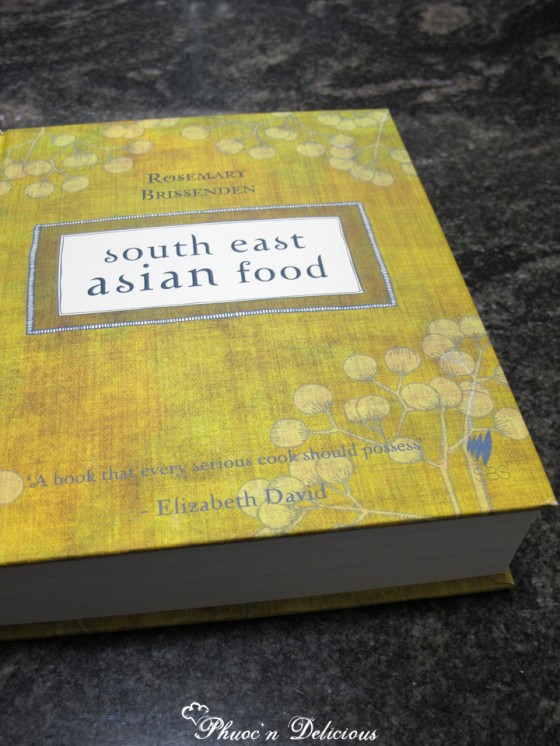
South East Asian Food by Rosemary Brissenden is a compilation of recipes from countries in the South East Asia region. The countries that are featured in this book are Cambodia, Thailand, Laos, Vietnam, Singapore, Malaysia and Indonesia. This cookbook is a revised and extended version of the original book that was released at least over 50 years ago. Back then, it was the first of its kind to attempt to knuckle down the cuisine of the South East Asian region. With all the advances in technology, increased air travel and the immigration of refugees from that region, cooking food that was once considered “exotic” is now made more accessible and achievable.
My first impression of the book was that it was massive! I was a little overwhelmed by the masses of recipes featured in this cookbook; but the structure of the book is well planned out, each country has a separate chapter and cooking methods within the cuisine is sub-divided further.
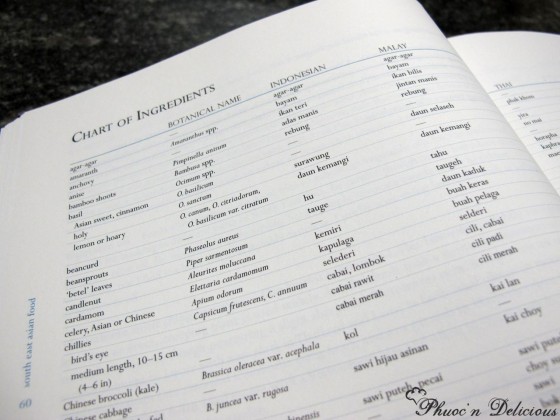
The books starts off an introduction of how to utilise the book in order to cook a meal that would be found on the tables of typical homes in South East Asia; these meals typically consist of several dishes served along side rice. Rice is an important commodity; unlike western views, it plays a vital role during meal times and the side dishes merely serve as supporting roles.
Unless stated otherwise, the suggested serving size of the recipes are for 3 people when one dish is prepared with rice, 6 people when 2 dishes are prepared and so on. In my opinion, I feel that having a serving suggestion number of “3” is odd as it makes increasing or decreasing the recipe a little difficult. Say for example you wanted to serve just one dish for 4 people, you’d have to multiply the recipe by 1.3; however, if the serving suggestion was 2 for example, you’d just have to multiply the ingredients by 2.
As everyone has different tastes, the recipe flavours are not set in stone, they only act as a guide. Flavouring through tasting during the cooking process and making adjustments to one’s own accord is encouraged.
There’s a good cover of ingredients common in South East Asian cooking; from agar agar to tempé to candlenut, each ingredient is explained properly, highlighting what it is, uses, and wherever possible, the preparation involved. Another thing that I liked was that there was a chart of ingredients, listing the name of an ingredient in English, it’s botanical name and in other South East Asian languages (where applicable); which would be useful if you’ve found an Asian grocer and where the they understand minimal English.
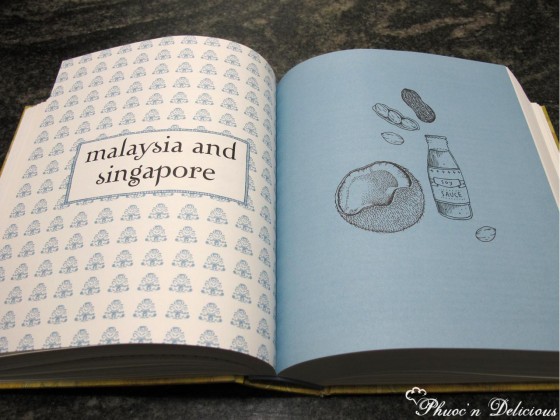
Each cuisine chapter starts off by providing an insight into the culinary, historical and cultural aspects of the cuisine. As mentioned, each country is sectioned into chapters and subdivided further into sections according to cooking method eg curries, braises, grilled/barbecued, steamed etc In the case of Malaysian and Singaporean food, it is further grouped into Malay, Chinese, Nyonya, Indian and Eurasian cuisine, and the subdivided into cooking methods.
To construct a meal from a particular country, a few dishes from different sections within the chapter are chosen and a variety of different ingredients are used.
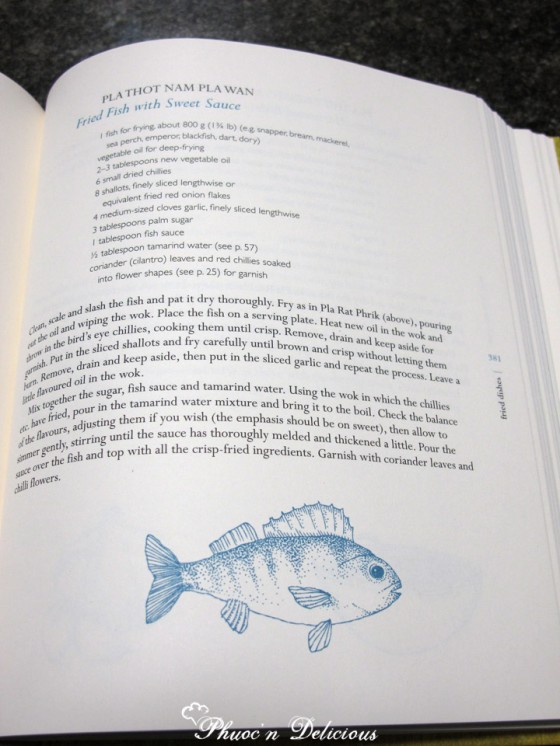
One of the things I noticed in this cookbook was that there were no pictures of the dishes what-so-ever. I tend to like to have pictures of food in cookbooks, the more pictures the better. However, I didn’t mind it so much that there were no pictures as I have some knowledge of South East Asian cooking and saw this book as a “bible” for South East Asian food (mind you, it’s not the be all and end all and not every single South East Asian dish is included in this cookbook). Having no visuals would be problematic for those who need guidance throughout the cooking process or need to know what the end dish is suppose to look like to either provide them reassurance that they’ve cooked the dish properly or entice them to make the dish.
Another thing I noticed in this cookbook was the vague steps that were provided in some of the recipes. For an experienced cook, this might not be an issue, but for someone who is a beginner it might seem a little daunting or confusing. For example, what would you have done if you read “simmer until you have a flavoursome broth”, “simmer uncovered, until the meat is tender..”? Not all recipes were like this though, some provided specific cooking times at specific steps which is always helpful.
Here are some of my final thoughts on the book:
- There are no visuals in this book; which may make things hard for those who rely on pictures to help them choose what to cook or guide them through the cooking process.
- Ideal for cooks who have some ideal on South East Asian cooking or those who are adventurous with their cooking.
- Extensive recipes which allows you to cook something you may have never heard of or encountered; these are the dishes that may be found typically in homes in South East Asian countries.
- Recipes can be somewhat vague at times, so there may be some incidences where inexperienced cooks may be confused with certain steps of the recipes.
Asian cooking isn’t something I tend to do, only because my parents haven’t really taught me and besides, most of the cooking is done by feel and the recipes and measurements aren’t that all exact. One night, I decided to volunteer myself to cook a Vietnamese pook belly braise dish for the family. In typical father-fashion, my dad had made several inputs to this dish as I was making it. He started off by pounding shallots, garlic and chilli (which isn’t mentioned in the recipe) in the mortar and pestle before I even had the chance to start cooking! Then when it came to the actual cooking process, he almost poured the coconut water into the saucepan before I had browned off the meat. I was actually surprised he didn’t start cooking the whole thing when I popped outside for a few hours. The dish was good but my dad still had to critique it; I can never win!
Thank you Steph from Hardie Grant Publishing for providing me this book to review.
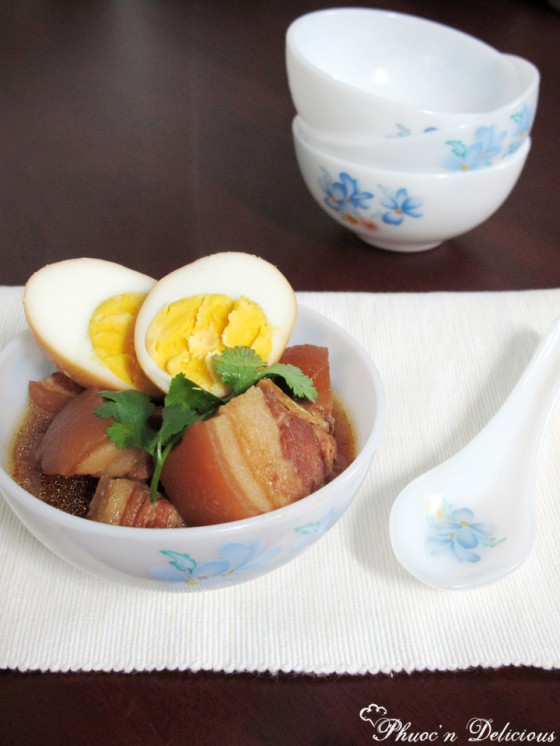
Thịt heo kho trứng (Vietnamese braised pork belly with boiled eggs)
Recipe
Recipe from South East Asian Food by Rosemary Brissenden
Serves 3
500g boned pork belly
3 cloves garlic, chopped
2 tbsp fish sauce, or more to taste
1 heaped tsp white sugar
1-2 tbsp vegetable oil
2 shallots or 1/2 brown onion, chopped
Juice from 1 fresh coconut or 1 can of coconut juice
1 tsp nước màu (caramel colouring) (recipe follows), to taste
4 hard-boiled eggs, shell peeled
Rice, to serve
- Cut the pork belly into 3cm cubes.
- Mix the garlic with fish sauce and 1 heaped teaspoon of sugar to make a marinade. Marinate meat for about 2 hours.
- Heat the oil in a medium saucepan, add the shallots and fry until soft.
- Brown the meat.
- Add remaining marinade, coconut juice and dark caramel syrup, and bring to boil.
- Taste and adjust seasoning (either with more nước màu or fish sauce). Place lid on, lower the heat and gently simmer for an hour.
- Add hard-boiled eggs (making sure they are fully submerged) and simmer for another 30 minutes, until the meat is tender.
- Serve with rice.
Nước màu (caramel colouring)
4 tbsp white sugar
4 tbsp hot water
- Melt sugar in a heavy-bottomed saucepan over high heat, stir until dark-brown colour. Remove from heat.
- Carefully add the hot water to the syrup and stir constantly.
- Place the saucepan back on heat to reduce to a dark and thick syrup.
- Cool and pour into a jar until required.


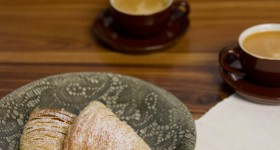
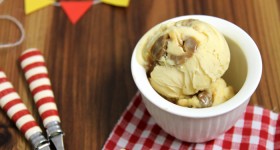
I’m the same as you, I don’t cook Asian food much because my parents haven’t really taught me and when my Mum tries, she’s super vague about it cos she doesn’t measure anything. That book does look like it has tons of recipes, pity about the lack of photos but your pork looks great!
that looks great Phuoc!
Thnx for the review Phuoc! Might check this book out. I love big fat books with lots of recipes 🙂
Yeah I must admit, Im not a massive fan of books with no images either. I like to see if mine looks like it should. Your’s looks awesome though!!
I think I should give this book a go, I really need to try to spruce up my asian knowledge of recipes… your dish is loooking yummy! 🙂
Great review, I’ve never really tried cooking many South-East Asian dishes, and this book looks intriguing.
Steph: I’d like to learn from them but it is hard because like you said, they don’t measure anything and if they do it’s not standardised lol Thanks, can’t go wrong with pork I’d say
Betty: Thanks 🙂
Sneh: Not a problem! I hope you like the book, it’ll definitely give you a different look into South East Asian food 🙂
Nic: I’m not too fussed; I like pictures but if there aren’t any then the text has to be engaging and not like a textbook which would send me to sleep.
Jenny: Thank you. That’s the reason why I decided to keep the book, to have something I can refer to for Asian recipes
JasmyneTea: Thank you 🙂 Maybe you can start with this dish, it’s something my dad makes at home every now and is pretty easy to put together; but most importantly it tastes great as well!
Great review! I tend to steer clear of Asian cooking since a lot of cookbook recipes aren’t ‘authentic’ in taste according to mum haha .. and when I’m watching mum cook she does everything by touch/feel/taste and never measures anything -.- I hope one day I can inherit her skills!
The pork belly looks phuoc’n yummy!
Hmmm mixed feelings – I love a comprehensive cookbook, but no images? How do I choose what I want to cook without eating the dishes up with my eyes first? Thanks for the review, I do think it’d be a handy book to keep on the shelf.
i am a major fan of thit heo kho, it’s such a major comfort food for me. i am not, however, a fan of cookbooks sans pix. great review, regardless.
Hmmm, this has made me realise that I don’t really measure when cooking Cantonese food either… More of visual ratios, which I suppose I could measure accurately if needs be =p But cooking by feel is great when making sauces and stews, as a lot of the time you can get an exact weight/measure of vegetables and kind of have to adjust for that as you go.
More Vietnamese cooking from you, I say!
Vivian: Thank you 🙂 It is sometimes hard to gauge what cookbook is authentic, but no matter what, I think our parents would always think that their way is always authentic and that no other cookbook can compare..
ChopinandMysaucepan: Hehe thank you
Keely: I know what you mean by that (we eat with our eyes) but I think sometimes you just need to be adventurous and the whole experience of not knowing what the dish is suppose to look like adds an element of surprise; you never know.. You might love the dish.
Lan: Thit heo kho is also comfort food for me, we tend it eat it with steamed brocoli now as well and I love dipping the brocoli into the sauce, so good!
Mademoiselle délicieuse: I’d like to master cooking by feel one day (and even cooking meals from random pantry/fridge items).. But yes, I intend to post more Viet recipes in the future…
The book seems thick. Not all Asian foods may be included in here but I can tell that almost everything Asian is compiled in this cook book! It looks beautiful despite the lack of picture. Besides, it seems like they already have some drawings in the book so not putting any images would mean being consistent with the whole thing, don’t you think? Too bad they didn’t include Philippines as I heard they’ve also got a lot of tasty cuisines.
I agree with you when you said that “cooking is done by feel.” Although I don’t like cooking that much, not that I’m such an expert on it, but whenever I cook, I don’t like to follow any certain process because of the fear that I might not get it right. For me, cooking should be done with a little creativity and imagination and I guess some feeling, too!
Tricia Miller: There was a mention in the book that Burmese and Filipino recipes were not included because 1) Burmese cuisine still remains foreign and 2) apparently the Philippines does not “fit in” with the “definition” of South East Asian cuisines as they haven’t been impacted with cultural Indianisation. Like you, I would have like to see some Filipino dishes featured in this book.
Well your end result looks great, and your dad is an absolute classic! One thing I like about this book, before even flipping through the recipes is………….. quantities for 3!!! Perfect for Mac, Josh and me 🙂
Sara: Yes it would be perfect for the Belly Rumbles family 😀